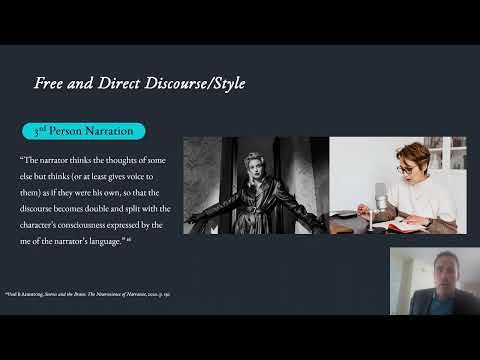 Speaker : Wilson, Jacob
Speaker : Wilson, Jacob
 Affiliation : Cardiff University
Affiliation : Cardiff University
Title : Self as Point of View : The Authorial “I’s” double-representation of self as a mechanism to revise core beliefs.
Abstract : I proceed from Donald Perlis rough definition of consciousness: “consciousness is the function or process that allows a system to distinguish itself from the rest of the world, conferring a point of view on the system ”. Perlis suggests that by symbolling the world, the brain creates a double-representation. This process of creating a symbol that exists both inside and outside of itself is fundamental to our ability to reevaluate beliefs. I argue the double representation required in Perlis’ symbolled-self is an analogous process to the doubling inherent in free indirect style/discourse. By drawing on similarities between Antonio Damasio’s neurobiological model of consciousness, what he calls the “enchainment of precedence’s ” and Italo Calvino’s “levels of literature” I show that symbolling process is how a writer creates points of view (authorial “I”, Narrator, Character) and how the Damasio’s core and autobiographical selves create core and extended consciousness.

 Long abstract
Long abstract
Whether it’s Henry James central intelligence, the modernists, stream of consciousness, or the post-modernists meta-fictional nods the reader—that seem to channel a bit of Buddhism, asking the reader to understand that you are not your thoughts; you are the observer of your thoughts—creative writers can be thought of as practitioner in the field of cognition, namely, some writers are attempting to replicate, understand, or invoke the effect of consciousness, and as such serve as an underutilized area of study and tool in the study of cognition and consciousness. This paper approaches the problem of self from the perspective of the fiction writer whose job it is to understand, develop, and craft unique points-of-view—it is a consideration of self as point-of-view.
To begin, I proceed from Donald Perlis rough definition of consciousness: “consciousness is the function or process that allows a system to distinguish itself from the rest of the world, conferring a point of view on the system ”. Perlis suggests that by symbolling the world, the brain creates a double-representation. This process of creating a symbol that exists both inside and outside of itself is fundamental to our ability to reevaluate beliefs. I argue the double representation required in Perlis’ symbolled-self is an analogous process to the doubling inherent in free indirect style/discourse. By drawing on similarities between Antonio Damasio’s neurobiological model of consciousness, what he calls the “enchainment of precedence’s ” and Italo Calvino’s “levels of literature” I show that symbolling process is how a writer creates points of view (authorial “I”, Narrator, Character) and how the Damasio’s core and autobiographical selves create core and extended consciousness.
The similarity between the act of writing and the neurological basis of self isn’t surprising from a writer’s perspective, namely because what a fiction writer is trying to do is create a fictional self, a perspective, a point-of-view that feels ‘real’ to a reader. It isn’t a large leap to think that reason a narrative ‘feels real’ is that the language engages the neurological systems that create the self. For example, the brain’s Default Mode Network (DMN) is highly active in self-referential activity, self-representation, autobiographical memory , and there is a growing body of research that shows that reading activates the DMN which is used to “process… a narrative as it unfolds. ”
Further, I argue core-beliefs are symbols that, once internalized by the autobiographical self fail to be represented as external symbols and thus can’t be doubly represented. This suggests that therapeutic writing’s success may be because of the authorial “I’s” capability to view the patient’s self and its schema as external symbols; generating a new double-representation and a means to reevaluate core-beliefs.

